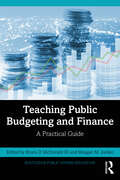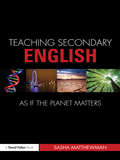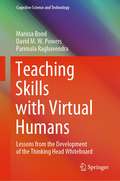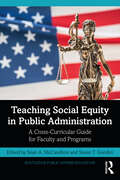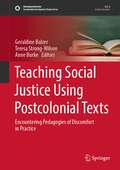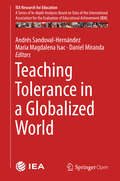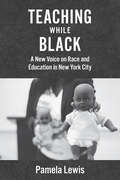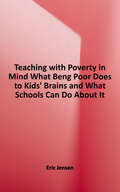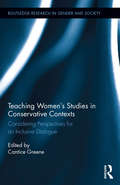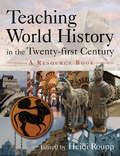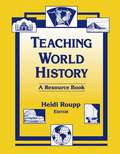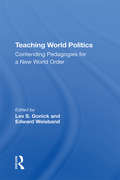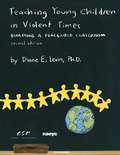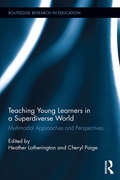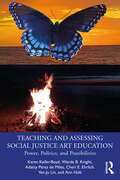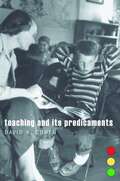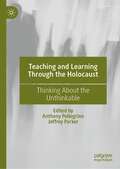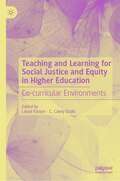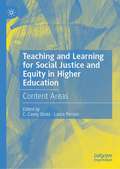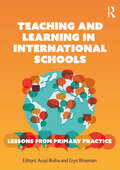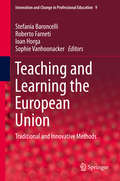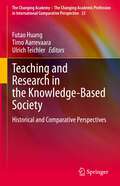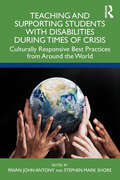- Table View
- List View
Teaching Public Budgeting and Finance: A Practical Guide (Routledge Public Affairs Education)
by Bruce D. McDonaldMany universities offer the Master of Public Administration (MPA) or other public affairs degree, which includes at least one course in public budgeting or public financial management. The faculty who teach these courses can however sometimes struggle to cover the breadth of material required and to fully engage students in what can be a technical subject. Teaching Public Budgeting and Finance: A Practical Guide addresses this challenge by sharing hands-on classroom expertise from leading scholars and creative instructors in the field. Drawing on their extensive experiences with teaching, researching, and engaging in service, each contributor reflects on how their area of expertise can be taught most effectively, providing a discussion of student learning outcomes, pedagogical approaches, relevant resources, and appropriate course assignments. While no one book can provide a final say on classroom instruction, this first-of-its kind primer on teaching public budgeting and financial management courses is a detailed, indispensable guide for all faculty looking to improve the learning experience of students in the classroom. Teaching Public Budgeting and Finance: A Practical Guide is required reading for early career faculty as they prepare to teach the course for what may be the first time, as well as for more senior faculty looking to update their course, complement their own teaching strengths, or teaching the course for the first time in several years.
Teaching Secondary English as if the Planet Matters
by Sasha Matthewman‘This is an important book for all concerned with the teaching and learning of English, exploring new and hugely significant areas in a scholarly, thought-provoking and eminently practical way.’ – David Stevens, University of Durham, UK Drawing together ideas from a range of disciplines in the study of texts which explore nature, the built environment and issues of climate change and environmental stress, this book shows how English is well placed to develop the cultural, aesthetic and emotional response to environmental themes – both as part of everyday practice and within wider curriculum innovations. Features include: critical reflection on the teaching of secondary English connections with the academic study of ecocriticism and/or key environmental issues suggested teaching activities and/or reflections from classroom practice sources of further reading and information. The true worth of a school subject is revealed in how far it can account for and respond to the major issues of the time. This timely textbook breaks new ground in showing how English teachers can have a pivotal role in responding to the environmental crisis.
Teaching Skills with Virtual Humans: Lessons from the Development of the Thinking Head Whiteboard (Cognitive Science and Technology)
by David M.W. Powers Marissa Bond Parimala RaghavendraThis book highlights current research into virtual tutoring software and presents a case study of the design and application of a social tutor for children with autism. Best practice guidelines for developing software-based educational interventions are discussed, with a major emphasis on facilitating the generalisation of skills to contexts outside of the software itself, and on maintaining these skills over time. Further, the book presents the software solution Thinking Head Whiteboard, which provides a framework for families and educators to create unique educational activities utilising virtual character technology and customised to match learners’ needs and interests. In turn, the book describes the development and evaluation of a social tutor incorporating multiple life-like virtual humans, leading to an exploration of the lessons learned and recommendations for the future development of related technologies.
Teaching Social Equity in Public Administration: A Cross-Curricular Guide for Faculty and Programs (Routledge Public Affairs Education)
by Sean A. McCandless and Susan T. GoodenPublic administration education programs prepare students in the provision of important public and nonprofit services, so it is essential that such programs help prepare administrators to advance social equity, one of the pillars of the discipline. This exciting new book from social equity authorities Sean McCandless and Susan T. Gooden demonstrates how public administration faculty can teach social equity across the curriculum, in practical terms. This edited collection features chapters from authors experienced in both public administration and in teaching social equity. Each chapter discusses teaching social equity in a particular class (Introduction to Public Administration, Organizational Dynamics and Theory, Human Resources, Policy Process, Research Methods, Capstones, and more) through distinct pedagogical practices that advance student learning (including case studies, community engagement projects, and simulations). The text captures an array of instructional approaches to social equity within public affairs education, particularly at the graduate level. It includes approaches from both established and newer instructors, across a diversity of universities. The book serves as an important resource to faculty who teach these courses, as well as the students who take them. Most importantly, it is a resource to academics and practitioners alike who share a commitment to fairness in the implementation of public services.
Teaching Social Justice Using Postcolonial Texts: Encountering Pedagogies of Discomfort in Practice (Sustainable Development Goals Series)
by Teresa Strong-Wilson Geraldine Balzer Anne BurkeThis book explores how teachers can re-examine their emotional investments in enacting dominant settler values through changing their text selection and teaching practices. Based on a longitudinal qualitative research study conducted by a national team of literacy scholars in collaboration with practicing literacy teachers at eight sites across Canada, the book investigates how groups of teachers, working collaboratively in inquiry groups, develop and implement curriculum to promote their own and their students’ understandings of social justice in postcolonial and settler spaces. In particular, the book highlights the rich and dynamic landscape of postcolonial authors, illustrators and texts, the development of culturally- sensitive curricula, and critical pedagogies possible in addressing contemporary and historical issues, both local and global. This book is primarily of interest to literacy scholars, literacy instructors (teacher educators) in teacher education programs, educational leaders, practicing teachers from the K-12 spectrum, and school district staff and policy makers with responsibilities for or interests in the potential of literacy and literature engagement for social justice education. The book is also be of interest to postsecondary educators and teacher educators wishing to use literature in social justice, anti-racist, and anti-oppressive courses.
Teaching Tolerance in a Globalized World (IEA Research for Education #4)
by Andrés Sandoval-Hernández Maria Magdalena Isac Daniel MirandaThis open access thematic report identifies factors and conditions that can help schools and education systems promote tolerance in a globalized world. The IEA’s International Civic and Citizenship Study (ICCS) is a comparative research program designed to investigate the ways in which young people are prepared to undertake their roles as citizens, and provides a wealth of data permitting not only comparison between countries but also comparisons between schools within countries, and students within countries. Advanced analytical methods provide insights into relationships between students’ attitudes towards cultural diversity and the characteristics of the students themselves, their families, their teachers and school principals. The rich diversity of educational and cultural contexts in the 38 countries who participated in ICCS 2009 are also acknowledged and addressed. Readers interested in civic education and adolescents’ attitudes towards cultural diversity will find the theoretical perspectives explored engaging. For readers interested in methodology, the advanced analytical methods employed present textbook examples of how to address cross-cultural comparability of measurement instruments and multilevel data structures in international large-scale assessments (ILSA). Meanwhile, those interested in educational policy should find the identification and comparison of malleable factors across education systems that contribute to positive student attitudes towards cultural diversity a useful and thought-provoking resource.
Teaching While Black: A New Voice on Race and Education in New York City
by Pamela LewisTeaching should never be color-blind. In a world where many believe the best approach toward eradicating racism is to feign ignorance of our palpable physical differences, a few have led the movement toward convincing fellow educators not only to consider race but to use it as the very basis of their teaching. This is what education activist and writer Pamela Lewis has set upon to do in her compelling book, Teaching While Black: A New Voice on Race and Education in New York City. As the title suggests, embracing blackness in the classroom can be threatening to many and thus challenging to carry out in the present school system.Unapologetic and gritty, Teaching While Black offers an insightful, honest portrayal of Lewis’s turbulent eleven-year relationship within the New York City public school system and her fight to survive in a profession that has undervalued her worth and her understanding of how children of color learn best. Tracing her educational journey with its roots in the North Bronx, Lewis paints a vivid, intimate picture of her battle to be heard in a system struggling to unlock the minds of the children it serves, while stifling the voices of teachers of color who hold the key. The reader gains full access to a perspective that has been virtually ignored since the No Child Left Behind Act, through which questions surrounding increased resignation rates by teachers of color and failing test scores can be answered. Teaching While Black is both a deeply personal narrative of a black woman’s real-life experiences and a clarion call for culturally responsive teaching. Lewis fearlessly addresses the reality of toxic school culture head-on and gives readers an inside look at the inert bureaucracy, heavy-handed administrators, and ineffective approach to pedagogy that prevent inner-city kids from learning. At the heart of Lewis’s moving narrative is her passion. Each chapter delves deeper into the author’s conscious uncoupling from the current trends in public education that diminish proven remedies for academic underachievement, as observed from her own experiences as a teacher of students of color. Teaching While Black summons everyone to re-examine what good teaching looks like. Through a powerful vision, together with practical ideas and strategies for teachers navigating very difficult waters, Lewis delivers hope for the future of teaching and learning in inner-city schools.
Teaching With Poverty In Mind: What Being Poor Does To Kids' Brains and What Schools Can Do About It
by Eric JensenIn this book, veteran educator and brain expert Eric Jensen takes an unflinching look at how poverty hurts children, families, and communities across the United States and demonstrates how schools can improve the academic achievement and life readiness of economically disadvantaged students. Jensen argues that although chronic exposure to poverty can result in detrimental changes to the brain, the brain's very ability to adapt from experience means that poor children can also experience emotional, social, and academic success. A brain that is susceptible to adverse environmental effects is equally susceptible to the positive effects of rich, balanced learning environments and caring relationships that build students' resilience, self-esteem, and character. Drawing from research, experience, and real school success stories, Teaching with Poverty in Mind reveals: - What poverty is and how it affects students in school. - What drives change both at the macro level (within schools and districts) and at the micro level (inside a student's brain)? - Effective strategies from those who have succeeded and ways to replicate those best practices at your own school. - How to engage the resources necessary to make change happen? Too often, we talk about change while maintaining a culture of excuses. We can do better. Although no magic bullet can offset the grave challenges faced daily by disadvantaged children, this timely resource shines a spotlight on what matters most, providing an inspiring and practical guide for enriching the minds and lives of all your students.
Teaching Women's Studies in Conservative Contexts: Considering Perspectives for an Inclusive Dialogue (Routledge Research in Gender and Society #48)
by Cantice GreeneWomen’s Studies is a field that inspires strong reactions, both positive and negative, inside and outside of the classroom. The field, partly due to its activist origins, is often associated with liberal ideology and is therefore chided by students and others who identify as conservative. The goal of this book is to introduce conservative perspectives into the issues of gender, sexuality, race, and power that are topics of teaching and discussion in women’s studies courses. The book also aims to provide examples of pathways by which conservative students and scholars can engage the field of women’s studies, not as opponents, but as contributors. Contributors including administrators, activists, scholar-teachers, artists, and ministers come together in this collection to engage in writing and response and to add their approaches to teaching and administering women’s studies on their campuses.
Teaching World History in the Twenty-first Century: A Resource Book
by Heidi RouppThis practical handbook is designed to help anyone who is preparing to teach a world history course - or wants to teach it better. It includes contributions by experienced teachers who are reshaping world history education, and features new approaches to the subject as well as classroom-tested practices that have markedly improved world history teaching.
Teaching World History in the Twenty-first Century: A Resource Book (Sources And Studies In World History Ser.)
by Heidi RouppThis practical handbook is designed to help anyone who is preparing to teach a world history course - or wants to teach it better. It includes contributions by experienced teachers who are reshaping world history education, and features new approaches to the subject as well as classroom-tested practices that have markedly improved world history teaching.
Teaching World History: A Resource Book (Sources And Studies In World History Ser.)
by Heidi RouppA resource book for teachers of world history at all levels. The text contains individual sections on art, gender, religion, philosophy, literature, trade and technology. Lesson plans, reading and multi-media recommendations and suggestions for classroom activities are also provided.
Teaching World Politics: Contending Pedagogies For A New World Order
by Edward Weisband Lev S. GonickIn this volume, scholars and teachers share ideas about new ways to teach history, culture and theory, as well as new topics such as gender, information flows and discourse. This book is the product of a series of roundtable discussions conducted under the auspices of the Annual Meetings of the International Studies Association. At both the 1991 Meetings in Vancouver and the 1992 Meetings in Atlanta we were extremely gratified by the response to our roundtables on Teaching World Politics in the 1990s.
Teaching Young Children in Violent Times: Building a Peaceable Classroom (Second Edition)
by Diane E. LevinA required book for early childhood educators, parents, and policy makers as it helps teachers create a Peaceable Classroom, where children learn peaceful alternatives to the violent behaviors modeled for them in society. <P><P>This extensively revised and updated edition features new material for a post-September 11th world including a new chapter on helping children deal with violence in the news.
Teaching Young Learners in a Superdiverse World: Multimodal Approaches and Perspectives (Routledge Research in Education #190)
by Heather Lotherington Cheryl PaigeThis book documents a collaborative action research project in one school where researchers and practitioners worked together to develop multimodal literacies and pedagogies for diverse, multilingual elementary classrooms. Following chronologically from Lotherington’s Pedagogy of Multiliteracies (2011), this volume picks up after teachers and researchers have learned how to work efficiently as a learning community to offer project-based learning approaches. This edited collection relates how teachers and students of different grade levels, language backgrounds, and abilities developed a shared agenda and created a framework for effective and inclusive practices. Contributors demonstrate that collaboration, creative pedagogical solutions and innovative project-based learning are all essential parts of learning and teaching socially appropriate and responsive literacies in a multimodal, superdiverse world.
Teaching and Assessing Social Justice Art Education: Power, Politics, and Possibilities
by Ann Holt Karen Keifer-Boyd Wanda B. Knight Adetty Pérez de Miles Cheri E. Ehrlich Yen-Ju LinThis incisive and wholly practical book offers a hands-on guide to developing and assessing social justice art education for K–12 art educators by providing theoretically grounded, social justice art education assessment strategies. Recognizing the increased need to base the K–12 curriculum in social justice education, the authors ground the book in six social justice principles–conceptualized through art education–to help teachers assess and develop curriculum, design pedagogy, and foster social justice learning environments. From encouraging teachers to be upstanders to injustice to engaging in decolonial action, this book provides a thorough guide to facilitating and critiquing social justice art education and engaging in reflexive praxis as educators. Rich in examples and practical application, this book provides a clear pathway for art educators to connect social justice art education with real-life educational assessment expectations: 21st-century learning, literacy, social skills, teacher performance-based assessment, and National Core Art Standards, making this text an invaluable companion to art educators and facilitators alike
Teaching and Its Predicaments
by David K. CohenEver since Socrates, teaching has been a difficult and even dangerous profession. Why is good teaching such hard work? In this provocative, witty, and sometimes rueful book, David K. Cohen writes about the predicaments that teachers face. Like therapists, social workers, and pastors, teachers embark on a mission of human improvement. They aim to deepen knowledge, broaden understanding, sharpen skills, and change behavior. One predicament is that no matter how great their expertise, teachers depend on the cooperation and intelligence of their students, yet there is much that students do not know. To teach responsibly, teachers must cultivate a kind of mental double vision: distancing themselves from their own knowledge to understand students’ thinking, yet using their knowledge to guide their teaching. Another predicament is that although attention to students’ thinking improves the chances of learning, it also increases the uncertainty and complexity of the job. The circumstances in which teachers and students work make a difference. Teachers and students are better able to manage these predicaments if they have resources—common curricula, intelligent assessments, and teacher education tied to both—that support responsible teaching. Yet for most of U.S. history those resources have been in short supply, and many current accountability policies are little help. With a keen eye for the moment-to-moment challenges, Cohen explores what “responsible teaching” can be, the kind of mind reading it seems to demand, and the complex social resources it requires.
Teaching and Learning Through the Holocaust: Thinking About the Unthinkable
by Jeffrey Parker Anthony PellegrinoThis book serves as a critical resource for educators across various roles and contexts who are interested in Holocaust education that is both historically sound and practically relevant. As a collection, it pulls together a diverse group of scholars to share their research and experiences. The volume endeavors to address topics including the nature and purpose of Holocaust education, how our understanding of the Holocaust has changed, and resources we can use with learners. These themes are consistent across the chapters, making for a comprehensive exploration of learning through the Holocaust today and in the future.
Teaching and Learning for Social Justice and Equity in Higher Education: Co-curricular Environments
by Laura Parson C. Casey OzakiThis book is the third in a four volume series that focuses on research-based teaching and learning practices that promote social justice and equity in higher education. In this volume, we focus on the application of the scholarship of teaching and learning in higher education outside of the classroom to maximize the effectiveness of student affairs programming. Specifically, authors focus on the application of SoTL in higher education outside of the classroom (e.g., faculty development, leadership, student involvement, student affairs) in ways that promote greater equity and inclusion in higher education. Each chapter includes a description of how higher education may traditionally marginalize students from underrepresented groups, outlines a research-based plan to improve student experiences, and provides a program or activity plan to implement the recommendations from each chapter.
Teaching and Learning for Social Justice and Equity in Higher Education: Content Areas
by Laura Parson C. Casey OzakiThis book explores theory and best practices to improve teaching and learning to promote equity in the classroom in specific disciplinary areas including STEM, healthcare, and the humanities. Each chapter includes actionable pedagogical or curricular recommendations such as course assignments and lesson plans. This is the second of four edited volumes focusing on applications of the Scholarship of Teaching and Learning (SoTL) for more equitable learning opportunities.
Teaching and Learning for the Twenty-First Century: Educational Goals, Policies, and Curricula from Six Nations
by Fernando M. Reimers and Connie K. ChungThis book describes how different nations have defined the core competencies and skills that young people will need in order to thrive in the twenty-first-century, and how those nations have fashioned educational policies and curricula meant to promote those skills. The book examines six countries—Chile, China, India, Mexico, Singapore, and the United States—exploring how each one defines, supports, and cultivates those competencies that students will need in order to succeed in the current century.Teaching and Learning for the Twenty-First Century appears at a time of heightened attention to comparative studies of national education systems, and to international student assessments such as those that have come out of PISA (the Program for International Student Assessment), led by the Organisation for Economic Co-operation and Development. This book&’s crucial contribution to the burgeoning field of international education arises out of its special attention to first principles—and thus to first questions: As Reimers and Chung explain, &“much can be gained by an explicit investigation of the intended purposes of education, in what they attempt to teach students, and in the related questions of why those purposes and how they are achieved.&” These questions are crucial to education practice and reform at a time when educators (and the students they serve) face unique, pressing challenges. The book&’s detailed attention to such questions signals its indispensable value for policy makers, scholars, and education leaders today.
Teaching and Learning in International Schools: Lessons from Primary Practice
by Anssi Roiha Eryn WisemanAn essential guide to teaching and learning in international schools for pre- and in-service educators around the world.With more and more teachers working in international schools, this book provides a practical and accessible examination of effective pedagogy in this specific context. Using case studies that can be applied in a range of settings, it explores key areas of classroom practice such as collaboration and student agency, along with emergent approaches such as play-based, concept-based and enquiry-based teaching and learning. In addition, it gazes towards students’ future needs, exploring themes such as new literacies and intercultural competence. “The thoughtful questions posed throughout the text have the potential to guide some important conversations and prompt positive, professional growth.” Kath Murdoch, Seastar Education Consulting.“This is a text that is much needed in national and international education.” Malcolm Nicolson, Director Erimus Education.“Modelling the power and value of collaboration, a cohort of very accomplished educators with international experience have united to share numerous practical examples to support effective teaching and learning. Dr Jennifer Chang Wathall, independent education consultant....connects readers to new or different researchers beyond what is shared in IB publications, therefore widening the research base and highlighting new strategies to help educators keen to innovate in their practice.” Sandy Paton, PYP Educator and independent consultant.
Teaching and Learning the European Union
by Stefania Baroncelli Roberto Farneti Ioan Horga Sophie VanhoonackerThis volume examines the EU's changing educational context and its challenges. Based on an extensive survey of more than 2000 European Studies courses in 30 European countries, it maps and analyses the features of teaching methodologies as they emerge from both disciplinary as well as interdisciplinary curricula. It presents a series of case studies on some of the most-used innovative teaching tools emerging in the field such as simulation games, e-learning, problem based learning, blended learning, and learning through the use of social networks. Based on the contributors' own experiences and academic research, the book examines both strengths and possible pitfalls of these increasingly popular methods. The book's critical approach will inspire educators and scholars committed to improving the teaching methods and tools in the area of European Studies and other programmes of higher education facing similar challenges.
Teaching and Research in the Knowledge-Based Society: Historical and Comparative Perspectives (The Changing Academy – The Changing Academic Profession in International Comparative Perspective #23)
by Ulrich Teichler Timo Aarrevaara Futao HuangThis book addresses common themes relating to the teaching and research nexus in the knowledge-based society through historical, comparative and empirical perspectives. It analyzes traditions of academic systems and national initiatives, and other factors affecting the main characteristics of the teaching and research nexus in eleven case countries from Asia, Europe, North America and South America. The book identifies key challenges of the academy, and trends in relation to the teaching and research nexus. The focus of case countries is on the attitudes and activities of the academy, as reported in the international comparative survey “The Academic Profession in the Knowledge-Based Society” (APIKS) in 2017-18. The data compared with previous international comparative survey “The Changing Academic Profession” (CAP) in 2007-08 in most chapters to make time series changes. The book discusses the teaching and research nexus in the case countries similar to and different from those of reference countries drawing on findings from the international databanks of the two international comparative surveys and previous research.
Teaching and Supporting Students with Disabilities During Times of Crisis: Culturally Responsive Best Practices from Around the World
by Pavan John Antony Stephen Mark ShoreThis volume offers international perspectives on the disproportionate impact COVID-19 has had on disabled students and their families, serving as a call to action for educational systems and education policy to become proactive, rather than reactive, for future disasters. Each chapter in the book is written by authors with lived experiences across diverse global regions, highlighting the daily life of people with disabilities and their families during the pandemic. Including case studies and practical suggestions, the book demonstrates that culturally responsive practices are essential to successfully support people around the world in their times of need. At the critical intersection of education and disability human rights, this book is important for pre-service teachers, researchers, professors, and graduate students to ensure all students are supported during times of crisis.
